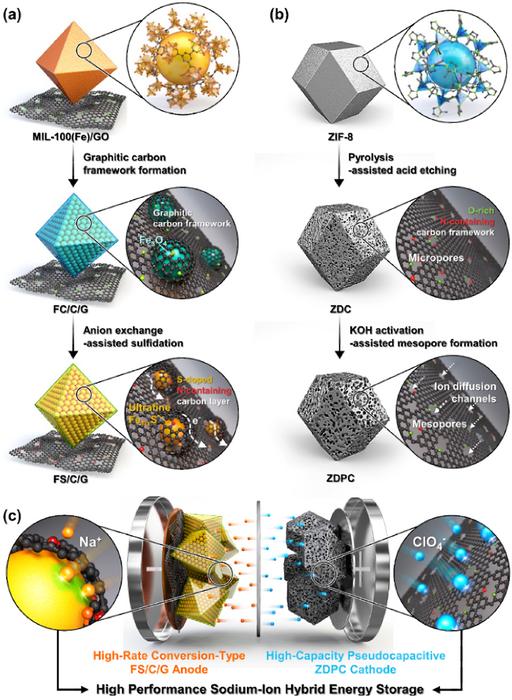Sodium-ion energy storage systems have garnered a lot of attention due to their superior safety, raw material costs, and environmental credentials compared to ubiquitous lithium-ion batteries. However, the technology is likely to challenge the incumbent only once costs are reduced by improving technical performance, establishing supply chains, and achieving economies of scale.
There are two types of sodium-ion energy storage systems: sodium-ion batteries and sodium-ion capacitors. The first are hindered by their poor rechargeability due to their low power density, while providing relatively high energy density. The latter, on the other hand, display high power density, but extremely low energy density. Hence, combining capacitor-type cathodes and battery-type anodes in sodium-ion hybrid energy storage (SIHES) cells has been an active area of research, bringing together the best of both worlds.
Now, KAIST researchers have reported a strategy to realize ultra-high-energy density and fast-rechargeable SIHES systems. They have utilized two distinct metal-organic frameworks for the optimized synthesis of hybrid batteries.
Their approach led to the development of an anode material with improved kinetics through the inclusion of fine active materials in porous carbon derived from metal-organic frameworks. Additionally, a high-capacity cathode material was synthesized, and the combination of the cathode and anode materials allowed for the development of a SIHES system, optimizing the balance and minimizing the disparities in energy storage rates between the electrodes.
The researchers have reported that the newly developed hybrid surpasses the energy density of commercial lithium-ion batteries and exhibits the characteristics of supercapacitors' power density.
Popular content
Namely, the SIHES demonstrated an energy density of 247 Wh/kg and a fast-rechargeable power density of 34,748 W/kg, exceeding battery-type reactions by more than 100 folds. It also demonstrated cycle stability with around 100 % Coulombic efficiency over 5,000 charge-discharge cycles.
The KAIST researchers anticipate broad applications for their new SIHES technology, ranging from electric vehicles to smart electronic devices and aerospace technologies.
They discussed their findings in “Low-crystallinity conductive multivalence iron sulfide-embedded S-doped anode and high-surface-area O-doped cathode of 3D porous N-rich graphitic carbon frameworks for high-performance sodium-ion hybrid energy storages,” which was recently published in Energy Storage Materials.
This content is protected by copyright and may not be reused. If you want to cooperate with us and would like to reuse some of our content, please contact: editors@pv-magazine.com.



OK, whenever I hear something like this, I have to do the math. If a Tesla S3 has a 40HWh battery, and you want to charge it in a few seconds (Let’s say 5 seconds). Well, you can’t get more out of a battery than what you put in. So, to charge a 40KWh battery, you need to put in 40KWh of power to the battery to get 40KWh out. So to put 40KWh into a battery in 5 seconds, you have to cram an amazing 28,800KWh of power into the battery for 5 seconds to fully charge the battery. Yeah, that’s almost 29 MEGA WATTS! I’m thinking that the charger cable would be turning into plasma at that power level. It wouldn’t be good. But this is also around the same amount of power consumed by a small city briefly. 29MW/240Volts yields a current of 120,000 Amps at nominal voltage levels (WOW!). Where could you get a connection that could pass that kind of current? So, my conclusion is that this is patently impossible to do. Physics just won’t allow this to happen without a large fire occurring.